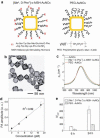In vivo molecular photoacoustic tomography of melanomas targeted by bioconjugated gold nanocages
- PMID: 20731439
- PMCID: PMC3065066
- DOI: 10.1021/nn100736c
In vivo molecular photoacoustic tomography of melanomas targeted by bioconjugated gold nanocages
Abstract
Early diagnosis, accurate staging, and image-guided resection of melanomas remain crucial clinical objectives for improving patient survival and treatment outcomes. Conventional techniques cannot meet this demand because of the low sensitivity, low specificity, poor spatial resolution, shallow penetration, and/or ionizing radiation. Here we overcome such limitations by combining high-resolution photoacoustic tomography (PAT) with extraordinarily optical absorbing gold nanocages (AuNCs). When bioconjugated with [Nle(4),D-Phe(7)]-alpha-melanocyte-stimulating hormone, the AuNCs can serve as a novel contrast agent for in vivo molecular PAT of melanomas with both exquisite sensitivity and high specificity. The bioconjugated AuNCs enhanced contrast approximately 300% more than the control, PEGylated AuNCs. The in vivo PAT quantification of the amount of AuNCs accumulated in melanomas was further validated with inductively coupled plasma mass spectrometry (ICP-MS).
Figures




References
-
- Srivastava A, Ralhan R, Kaur J. Angiogenesis in Cutaneous Melanoma: Pathogenesis and Clinical Implications. Microsc. Res. Tech. 2003;60:208–224. - PubMed
-
- Shivers SC, Wang X, Li W, Joseph E, Messina J, Glass LF, DeConti R, Cruse CW, Berman C, Fenske NA, et al. Molecular Staging of Malignant Melanoma: Correlation with Clinical Outcome. J. Am. Med. Assoc. 1998;280:1410–1415. - PubMed
-
- Rudin M, Weissleder R. Molecular Imaging in Drug Discovery and Development. Nat. Rev. Drug. Discov. 2003;2:123–131. - PubMed
-
- Gambhir SS. Molecular Imaging of Cancer with Positron Emission Tomography. Nat. Rev. Cancer. 2002;2:683–693. - PubMed
-
- McDonald DM, Choyke PL. Imaging of Angiogenesis: from Microscope to Clinic. Nat. Med. 2003;9:713–725. - PubMed
Publication types
MeSH terms
Substances
Grants and funding
LinkOut - more resources
Full Text Sources
Other Literature Sources

